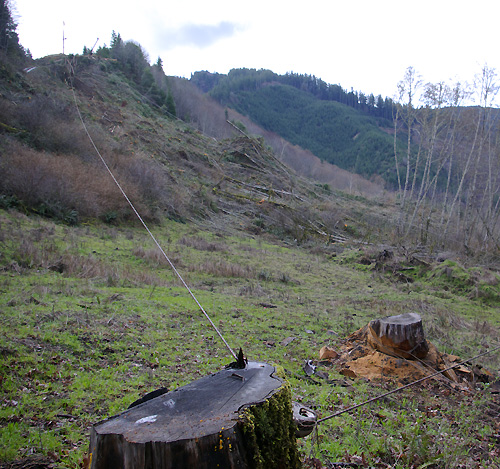Today I took my camera and dogs on a walk up the hill from our ranch house to where we are doing some logging — about 20 acres of mixed alder and fir trees. It’s March 3rd, which is very early to start logging. There’s mud everywhere because it has rained about 6 inches in the last week. But the ranch needs the income, and we were fortunate to find a mill that is buying the timber at a decent rate right now, and a logger willing to do the work at this time of year. Loggers have been hard hit because of the same factors I will now list; it seems they need the money now too, enough to work in the rain and mud.
As I understand it, because of the problems with the banks and mortgages and the way the economy seems to be falling apart, there has been a dramatic decrease in housing starts (at the lowest rate in 50 years, if the news is to be believed). So the prices for timber for the last year or so have been abysmal; there’s no demand for the wood used to make homes, if no one is making new homes. New housing starts are a good way to predict how much wood is going to be used in the coming months.
Add the low prices for timber to the high cost of fuel last summer (over $5.00 a gallon for diesel), and the conditions were such that it would have actually cost us money to cut down the trees and take them to the mill for most of last year. The net result would have been the ranch owing money to the loggers doing the work.
We haven’t done any logging for the last couple of years; but now the conditions are right and we can make the money needed to float the ranch for the next year or two. I am not a ranch owner, so make nothing from this logging. I’m just an observer and the un-official photographer and official kibbitzer.
They came a few weeks ago and cut down the trees. Let me tell you a little about that.
Loggers start work very early and quit work early. The chain saws started at about 4:30 AM, and the crashing of trees coming down got pretty intense by about 5:00 AM. (They were cutting down some large trees not 50 yards from our house. It’s amazing what you can sleep through if you are determined to do so.) They knock off at about noon, after having put in a full day’s work. I can only imagine that they drive home, drinking themselves silly on the way there, judging by the number of empty beer cans we pick up from our road, and go to bed by 6:00 PM so they can get up at 2:00 AM so they can come out here and work in the dark for three hours before the sun comes up. Their schedule seems insane to me. Why not start work after a nice cup of coffee, at about 8:00 AM, when it is good and light and you can see your chain saw? But their schedule is based around when the mills are open, what hours they are allowed to log (federal and state regulations, thank you very much) and how long it takes the first loads of log trucks to get to the mills. Or so I have been told.
Today the “yarder” arrived, which is a big caterpillar-treaded machine with a “yard” on it. The yard sticks way up in the air (like the mast of a ship — I’m pretty sure it’s from the same root as “yard” on a ship) and has big steel cables that come down from the top of it, that are attached to some old tree stumps and some large trees (with wide bands to keep from stripping the bark off the living trees). Those cables anchor the yard in place, and it then has a pulley system that runs down those same cables and retrieves the logs, bringing them through the air along the cables, up to the “landing”, where the yard is located. This keeps the trees from gouging huge furrows in the dirt, or at this time of year, from making canals in the mud.

Stump with cable running up to the Yarder
It is the job of the “choker setter” (evidently a very junior kind of logger judging from how hard they work) to put “choker cables” around the logs laying about, and to attach those choker cables to the big pulley on the cables. And then to get the hell out of the way while they are pulled through the air up to the landing. And then do it again with another batch of logs. I get tired just thinking about how much hard work they do.
Upon arrival at the landing, the trees are de-limbed very neatly by a machine that simply picks them up and stuffs them through a large hole, thereby breaking off all the limbs very near to the trunk, then the resulting logs are sorted and stacked by the operator of a big machine colloquially called a “shovel” (although it isn’t like any shovel you’d recognize). It has a kind of claw on the end of a boom, which it uses to grab half a dozen logs at a time and place them gently onto the log trucks. The trucks come roaring up and down the hill and take the logs away to the mill; it’s a ballet of gross proportions, not without its own beauty, and everything has to be timed just right to avoid wasted time, effort and expense.

A Shovel
At the end of all this, the logs basically end up as numbers deposited to the ranch’s bank account.
The loggers will also leave us a stack of “unmarketable” wood, which we turn into firewood that we will use over the next several years. According to our logger, apparently one log truck load of logs contains about 5-7 cords of wood. We go through about that much wood over the course of a winter in our expensive, clean-burning, ultra-efficient woodstove, which does a great job of heating our home.
So this afternoon I walked up the hill and took some photos. But I didn’t expect to see this, looking out past all the devastation of the downed trees:


Lovely!
Rainbows are not easy to catch. You did it. Good for you. Argie